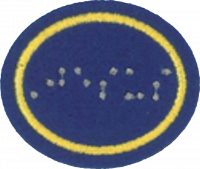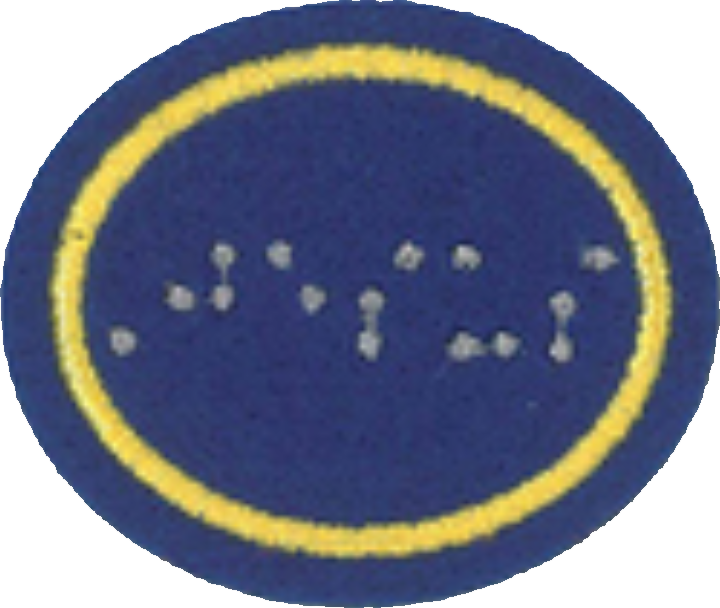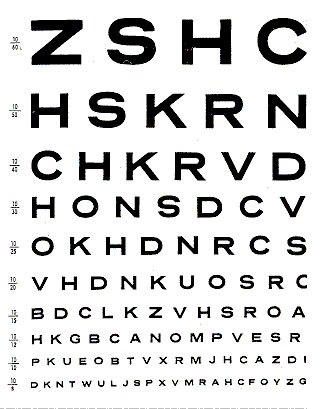Especialidades JA/Braille/Respuestas
1
Un método de impresión destinado a ser leído sin ver, normalmente con los dedos.
2
Las personas que son legalmente ciegas, que tienen una agudeza visual de 20/200 o peor con lentes correctivos, generalmente no pueden leer letras grandes o incluso la letra más grande en una tabla optométrica colocada a 20 pies de distancia.
Aquí hay una definición adicional de Kenneth Jernigan, líder desde hace mucho tiempo de la Federación Nacional de Ciegos: «Uno es ciego en la medida en que el individuo debe idear técnicas alternativas para hacer de manera eficiente aquellas cosas que haría si tuviera una visión normal» &
2a
Nota: esta actividad no está diseñada para diagnosticar problemas visuales. Indique a los estudiantes que hagan un seguimiento con su proveedor de salud ocular con respecto a cualquier problema de la vista.
2b
Actividad: ¿Tiene sensibilidad epicrítica?
Una forma fácil de probar es sentir texturas en varias superficies.
Instructores: Arregle un área con artículos comúnmente disponibles, como papel de lija, un cuaderno de espiral, bloques LEGO, papeles lisos y texturizados, etc. Los estudiantes pueden probar su capacidad para sentir diferentes texturas para evaluar su sensibilidad epicrítica.
Nota: Incluso si una persona tiene una sensibilidad epicrítica, se necesitan años para que una persona aprenda braille. El primer paso útil es reconocer esta sensibilidad, seguido de la práctica de reconocer las células braille como contenido significativo. De la misma manera que los niños con visión tardan años en aprender a leer y escribir en su idioma nativo, la adquisición de la alfabetización en braille también requiere tiempo, capacitación y mucha práctica.
Además, una sensibilidad epicrítica razonablemente alta, la capacidad de distinguir entre pequeñas variaciones, es útil al leer braille. La mayoría de las personas que aprenden a usar braille usarán los dedos, aunque algunas pueden leerlo visualmente y otras pueden usar otra parte del cuerpo, como la lengua, cuando los dedos pierden la sensibilidad epicrítica o si se pierden todos los dedos juntos.
3
3a
Louis Braille fue un educador, inventor y músico francés que creó el braille porque quería cerrar la brecha entre las personas ciegas y las personas videntes. Louis nació en 1809 y quedó ciego de ambos ojos como resultado de un accidente infantil. Asistió al Institut National des Jeunes Aveugles (Instituto Real de Jóvenes Ciegos), que fue la primera escuela especializada en el mundo para personas ciegas. Louis aprendió a leer el sistema Haüy de letras impresas en relieve en latín. El método de impresión para el sistema Haüy utilizó papel húmedo y alambre de cobre. Debido a la complejidad de la impresión de Haüy, este sistema era prácticamente inutilizable para personas ciegas como sistema de escritura, además de ser difícil de leer.
Louis, frustrado, estaba decidido a inventar un sistema de lectura y escritura que pudiera salvar la brecha en la comunicación. «El acceso a la comunicación en el sentido más amplio es acceso al conocimiento, y eso es de vital importancia para nosotros si nosotros [los ciegos] no queremos seguir siendo despreciados o patrocinados por personas videntes condescendientes. No necesitamos piedad, ni necesitamos que nos recuerden que somos vulnerables. Debemos ser tratados como iguales, y la comunicación es la forma en que esto se puede lograr.» - Louis Braille, 1841&
En 1821, Louis se enteró de un sistema de comunicación ideado por el capitán del ejército francés Charles Barbier, llamado «Night Writing [Escritura nocturna]», que constaba de una celda de hasta 12 puntos dispuestos en dos columnas. Parte de lo que hizo atractivo este sistema fue que los lectores de este sistema también podían escribirlo sin el complicado equipo que requerían otras fuentes táctiles en ese momento. Haüy, por ejemplo, requería alambre de cobre y papel húmedo, además del espacio para secarlo.
Louis adaptó el código del Capitán Barbier en celdas de puntos en relieve, dos de ancho y hasta tres de alto, completando la mayor parte de este trabajo a los 15 años. Aunque muchos lo reconocen como un sistema ingenioso y útil, el Braille no fue adoptado por el Instituto Real para Jóvenes Ciegos, y más tarde en todo el mundo, hasta dos años después de la muerte de Louis a los 43 años.
3b
4
5
6
7
Las respuestas variarán según cada club y Conquistador.
8
9
Summary:
- Lost his eyesight due to complications from contracting Diphtheria as a child.
- Learned braille from damaged printing plates.
- With approval of the General Conference Committee, created a Christian braille publication, The Christian Record, using homemade materials. The first edition was sent to subscribers in January 1900. The Christian Record (now called Christian Record) continues to be distributed today.
Founder of Christian Record Services, Inc. (DBA Christian Record Services for the Blind, DBA National Camps for Blind Children)
Note: The following selection includes adapted excerpts of an unpublished historical overview, Christian Record: Yesterday, Today, and Tomorrow by John Treolo, who worked in the organization’s communication office in the 1970s and 80s.
Austin O. Wilson, an early Adventist pioneer, was born in Ionia, Michigan, on January 27, 1873, and was raised in a Seventh-day Adventist home. (Note: The Seventh-day Adventist Church was founded just 10 years earlier.)
At age seven, Austin and his family moved to Dunbar, Nebraska, where his father had accepted a call to be a colporteur for the then Nebraska Conference. Shortly thereafter, Austin and his brother, George, contracted Diphtheria and Austin’s sight was severely impaired.
Austin was unable to continue in public schools as a result of his failing eyesight. His mother took him to Battle Creek, Michigan, to be seen by Dr. John Harvey Kellogg, but to no avail. The trip was successful in another way, as they discovered the Michigan School for the Blind in Lansing, where Austin enrolled and took classes to learn New York Point.
Thrilled with this knowledge, Austin returned to Nebraska in 1890 and completed the four-year high school course at the Nebraska City School for the Visually Handicapped. Realizing he would need a skill to earn a living, he trained to tune pianos while in school. In 1894, he moved to Chicago to put his piano-tuning skills to practice in a piano factory.
While in Chicago, Austin attended a school for Bible workers and was encouraged to return to Battle Creek to train to work for the Lord. Arriving back at Battle Creek with 25 cents in his pocket, he attended camp meeting and visited his former school. During his visit, Austin discovered a new form of tactile reading: braille. During that camp meeting, he taught himself to read braille using damaged printing plates.
As Austin began to read everything in braille he could get his fingers on, he noticed a lack of Christian reading materials. Feeling a deep burden for the spiritual needs of people who are blind, he accepted the challenge of supplying wholesome, inspirational literature to the sightless.
During this time, there were inventions to speed up the process of braille production, including the Braillewriter and the stereotyper. With these machines, Austin convinced L.T. Nicola, secretary and treasurer of the International Tract Society (forerunner to the Adventist Book Center) that embossing could be done quickly, and thus 10 tracts were made on topics ranging from "The Children’s Privilege" to "What Must I Do to be Saved?" each selling from between five and 15 cents.
Although thrilled with the progress made in providing Christian braille materials, Austin had one more hurdle to complete: a monthly Christian magazine for people who are blind.
In June 1899, Austin married Johanna Burgerson, who was also blind, and enrolled at the Iowa School for the Blind in 1887, two years before Mary Ingalls, from Little House on the Prairie fame, graduated.
Now Austin had a companion who shared his vision. Together, with G. A. Irwin, General Conference President, they pleaded [to the General Conference for funds and authorization to publish] and worked. In October 1899, the General Conference Committee gave its blessing to begin production. By January of 1900, using a washing machine hand wringer, the first 75 copies of the first issue of The Christian Record was produced in both braille and New York Point.
A yearly subscription for this monthly magazine was US$1.50 (approximately $30 in today’s money). However, even with what appeared to be a meager amount of money, The Christian Record was unaffordable for most people who were blind. An appeal was made to church leaders to collect money for these subscriptions.
In 1901, Austin reported to the General Conference Committee that subscriptions to The Christian Record had increased to 200, and each issue contained between 20 to 24 pages.
By 1907, it was reported that nearly 50 people who are blind had joined the Seventh-day Adventist Church. "These persons were not visited by Bible workers; they accepted the truth by reading the Christian Record and tracts. Already this year a goodly number have embraced the message, and many others are interested" (Lee Muck, Christian Record employee and Christian Record editor, 1902–1907, 1912–1913).
By the following year, circulation of The Christian Record had increased internationally, with subscriptions in Canada, Mexico, Australia, and England, and a readership of over 2,000. Toward the end of 1908, Austin and the Christian Record decided to take advantage of the 1904 Congressional Postal Act, enabling free shipping of embossed books and publications. One of the first books printed in braille by the Christian Record staff was the Bible. Because of this reduction in cost and successful fundraising, the $2 subscription fee for The Christian Record was removed. It has remained free for people who are blind to this day.
One prominent subscriber to The Christian Record was Helen Keller, the first deaf-blind American author, political activist, lecturer, to earn a Bachelor of Arts degree, wrote this note to the Christian Record staff:
"Dear Friends,
It is a happiness to me to know of your warm-hearted efforts to help the blind. It is help indeed — giving them light which no darkness can quench. I hope that more and more of the blind who wander comfortless in desert ways will hear the messages of love and peace which The Christian Record scatters far and wide. There is a cheery, stimulating spirit in the magazine too, and this is another greatly needed service to the sightless.
"I thank you for the sweet story which you published in the Christmas number. I am sure no one who had read it will forget its beautiful lesson.
"I rejoice in the encouragement which you have given to the blind to be as self-supporting as possible. Yes, work which they can do and do well, and in a noble spirit, is the best way to worship God and to serve their fellow men.
"Wishing you and The Christian Record continued success, I am.
"Sincerely yours,
Helen Keller"''
In 1916, Austin retired due to poor health. A year later his wife, Johanna, also resigned due to health reasons.
Note: As of the writing of this honor, The Christian Record, now titled Christian Record, continues to be produced in braille and is distributed free-of-charge to subscribers in the United States, Canada, Bermuda, and Guam-Micronesia.
10
10a
Before the visit, ask students to write down their predictions about their perceptions of blind people. Collect and keep responses to review after the visit.
- What can a person who is blind do?
- How does a person who is blind cook, clean, etc.?
- What jobs can a person who is blind do well?
- What scares you about people who are blind?
- Are you scared of becoming blind? Why?
- Do all people who are blind see nothing? (Are there different kinds of blindness?)
10b
Before the visit, ask students to write down their predictions about their perceptions of blind people. Collect and keep responses to review after the visit.
- What can a person who is blind do?
- How does a person who is blind cook, clean, etc.?
- What jobs can a person who is blind do well?
- What scares you about people who are blind?
- Are you scared of becoming blind? Why?
- Do all people who are blind see nothing? (Are there different kinds of blindness?)
Following the activity, do a club debrief. Ask the same questions as before and refer to prior responses. Ask additional questions.
- How did the person you visited read and write? Do all people who are blind read braille?
- Are you scared of people who are blind? What changed your mind?
- What surprised you from today’s visit?
- What can your club do to form a friendship with people who are blind?
- How can you share the love of Jesus with someone who is blind?
- In one sentence, share what you learned from today’s visit.
References
Additional Resources:
- As I Saw It, Robert B. Irwin, American Foundation for the Blind, 1955. Available online.
- Learn to Read Braille in One Lesson,In One Lesson YouTube channel
- Louis Braille Online Resource
- New York Institute for Special Education, “History of Writing Codes for the Blind.” Available online.




